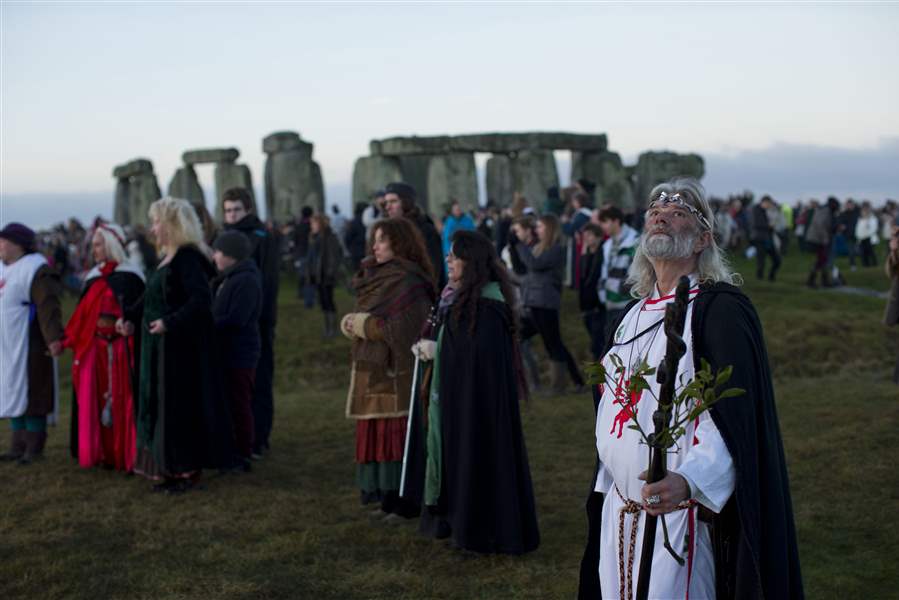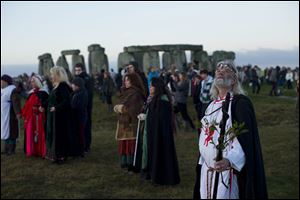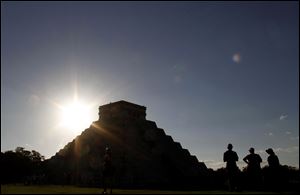
Mayan skulls say to forget apocalypse
Ritual predicts new era, not end of times
12/21/2012
Druid leader Arthur Uther Pendragon, right, looks up as people face east to watch the sunrise by the ancient stone circle of Stonehenge, in southern England, as access to the site is given to druids, New Age followers and members of the public on the annual Winter Solstice.
Associated Press

People in alien costumes stand on a street in the town of Bugarach, France.
MERIDA, Mexico — The crystal skulls have spoken: The world is not going to end.
American seer Star Johnsen-Moser led a whooping, dancing, drum-beating ceremony Thursday in the heart of Mayan territory to consult several life-sized crystal skulls, which adherents claim were passed down by the ancient Maya.

Druid leader Arthur Uther Pendragon, right, looks up as people face east to watch the sunrise by the ancient stone circle of Stonehenge, in southern England, as access to the site is given to druids, New Age followers and members of the public on the annual Winter Solstice.
The supposed end of the Maya long-count calendar today prompted a wave of global doomsday speculation.
“This is not the end of the world, this is the beginning of the new world,” Ms. Johnsen-Moser said at a gathering of hundreds of spiritualists at a convention center in Merida. “It is most important that we hold a positive, beautiful reality for ourselves and our planet. ... Fear is out of place.”
The supposed 5 a.m. doomsday hour had arrived in several parts of the world with no sign of the apocalypse.
The social network Imgur posted photos of clocks turning midnight in the Asia-Pacific region with messages such as: “The world has not ended. Sincerely, New Zealand.”
NASA is so sure there will be a Dec. 22, 2012, it has posted a YouTube video titled, “Why the World Didn’t End Yesterday.”
Scientists say rumors on social media and the Internet of Earth’s demise have been prompted by a misunderstanding of the ancient Maya calendar, which runs through Dec. 21, 2012.
“It’s just the end of the cycle and the beginning of the new one. It’s just like on Dec. 31, our calendar comes to an end, but a new calendar for the next year begins on Jan. 1,” said Don Yeomans, head of NASA’s Near-Earth Object program at the Jet Propulsion Laboratory in Pasadena, Calif.
According to the story circulating on the Internet, an enormous rogue planet called Niburu is on a collision course with Earth.
“If it were, we would have seen it long ago, and if it were invisible somehow, we would have seen its effects on the neighboring planets. Thousands of astronomers who scan the night skies on a daily basis have not seen this,” Mr. Yeomans said.
Thousands of mystics and New Age dreamers have descended on ancient Maya temples across Mexico and Central America hoping to witness the birth of an era when the day dubbed “end of the world” dawns today.
So is NASA covering up to prevent panic?
“Can you imagine thousands of astronomers keeping the same secret from the public for several years?” Mr. Yeomans said.

A couple poses for their wedding pictures in Hong Kong Friday Dec. 21, 2012. Many people around the world believe that the Mayan people predicted the end of the world Dec. 21.
Initially, Niburu, also known as Planet X, was to impact in May, 2003, but when that didn’t happen, the doomsday date was moved to coincide with the end of one of the cycles of the ancient calendar at winter solstice — Dec. 21, 2012.
Other celestial events that will not be happening: a planetary alignment causing a massive tidal surge or a total blackout of Earth; a reversal in Earth’s rotation; an impact by a giant asteroid, and a giant solar storm.
“Since the beginning of recorded time, there have been literally hundreds of thousands of predictions for the end of the world,” Mr. Yeomans said. “We’re still here.”
In Merida, the celebration of the cosmic dawn began with a fumbling of the sacred fire meant to honor the calendar’s conclusion.
Gabriel Lemus, the white-haired guardian of the flame, burned his finger on the kindling and later had to scoop up a burning log that was knocked out of the ceremonial brazier onto the wooden stage.
Still, Mr. Lemus was convinced that it was a good start, as he was joined by about 1,000 other shamans, seers, stargazers, crystal enthusiasts, yogis, sufis, and swamis at the convention center about an hour and a half from the Mayan ruins at Chichen Itza.
“It is a cosmic dawn,” he said. “We will recover the ability to communicate telepathically and levitate objects ... like our ancestors did.”

People gather in front of the Kukulkan Pyramid in Chichen Itza, Mexico on Thursday.
The summit is scheduled to run through the end of the world to Sunday.
Participants say they will celebrate the birth of an age.
Not all seers endorse the celebration.
Mexico’s self-styled “brujo mayor,” or chief soothsayer, Antonio Vazquez Alba, warned followers to stay away from all gatherings today.
“We have to beware of mass psychosis” that could lead to stampedes or “mass suicides, of the kind we’ve seen before,” he said.
“If you get 1,000 people in one spot and somebody yells, ‘Fire!’ watch out,” Mr. Vazquez Alba said. “The best thing is to stay at home, at work, in school, and at some point do a relaxation exercise.”
Organizers of Yucatan’s broader Mayan Culture Festival saw the need to answer the now-debunked idea that the Mayas, who invented an amazingly accurate calendar almost 2,000 years ago, had somehow predicted the end of the world.
The Mayas measured time in 394-year periods known as baktuns. Anthropologists believe the 13th baktun ends around Dec. 21, and 13 is considered a sacred number for the Maya.
But archaeologists have uncovered Mayan glyphs that refer to dates far, far in the future, long beyond today’s date.